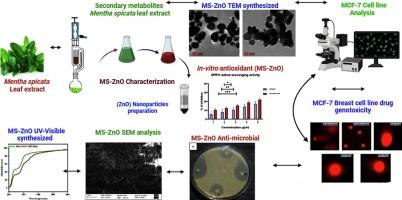Biosynthesis of ZnO nanocomposites from Mentha spicata applications of antioxidant, antimicrobial and genotoxicity advances in MCF-7 cell line
IF 5.4
Q1 CHEMISTRY, ANALYTICAL
引用次数: 0
Abstract
This study focuses on enhancing the, Spearmint (Mentha spicata), an aromatic herb indigenous to Europe and Asia, which is valued for its refreshing flavor and potential health benefits. This herb is widely utilized in culinary practices, medicinal applications, and cosmetic formulations. The ethanol extract derived from the M. spicata leaf contains is rich secondary metabolites with various bioactive properties: Specifically, such as tannins, flavonoids, and polyphenols are known for their antioxidant and anti-inflammatory effects, saponins help reduce cholesterol, and alkaloids have analgesic properties. The extract has a total flavonoid content (TFC) of 231.37 ± 2.05 mg GAE/g and a total phenol content (TPC) of 247.32 ± 5.07 mg GAE/g. Zinc oxide (ZnO) nanoparticles were synthesized from this extract and subsequently characterized through various analytical techniques. The absorbance measurement at 437 nm confirmed the successful nanoparticle synthesis. FTIR spectra showed water-related absorption bands at 3330 cm−1 and 3337 cm−1. Scanning electron microscopy (SEM) indicated the presence of spherical nanoparticles of about 25.4 nm, while transmission electron microscopy (TEM) illustrated particles ranging from 20 to 50 nm with high crystallinity and a lattice spacing of 0.297 nm. X-ray diffraction (XRD) analysis confirmed their crystalline structure with distinct Bragg reflections at 39.1°, 46.1°, 68.7°, and 79.2°, which corresponding to (111), (200), (220,311) planes, respectively (JCPDS card no. 01–080-1876). Energy-dispersive X-ray spectroscopy (EDX) confirmed the high purity of the synthesized ZnO nanocrystals. The nanoparticles demonstrated significant antioxidant activity with radical scavenging rates up to 97.33 %, effective antimicrobial properties, and notable anticancer activity, achieving 99.75 % inhibition of MCF-7 cells at 40 μg/mL. These findings highlight the nanoparticles' potential applications in health and medicine.

薄荷纳米氧化锌复合材料的生物合成在 MCF-7 细胞系中的抗氧化、抗菌和遗传毒性应用进展
薄荷(Mentha spicata)是一种原产于欧洲和亚洲的芳香草本植物,因其清新的味道和潜在的健康益处而备受青睐。这种香草被广泛用于烹饪、医药和化妆品配方中。从刺五加叶中提取的乙醇萃取物含有丰富的次生代谢物,具有多种生物活性:其中,单宁酸、类黄酮和多酚具有抗氧化和消炎作用,皂甙有助于降低胆固醇,生物碱具有镇痛作用。提取物的总黄酮含量(TFC)为 231.37 ± 2.05 毫克 GAE/克,总酚含量(TPC)为 247.32 ± 5.07 毫克 GAE/克。用这种提取物合成了纳米氧化锌(ZnO)颗粒,随后通过各种分析技术对其进行了表征。在 437 纳米波长处测量的吸光度证实了纳米颗粒的成功合成。傅立叶变换红外光谱在 3330 cm-1 和 3337 cm-1 处显示了与水有关的吸收带。扫描电子显微镜(SEM)显示存在约 25.4 纳米的球形纳米颗粒,而透射电子显微镜(TEM)则显示颗粒大小为 20 至 50 纳米,结晶度高,晶格间距为 0.297 纳米。X 射线衍射(XRD)分析证实了它们的晶体结构,在 39.1°、46.1°、68.7° 和 79.2°处有明显的布拉格反射,分别对应于 (111)、(200) 和 (220,311) 平面(JCPDS 卡号 01-080-1876)。能量色散 X 射线光谱(EDX)证实合成的氧化锌纳米晶体纯度很高。该纳米粒子具有显著的抗氧化活性(自由基清除率高达 97.33%)、有效的抗菌特性以及明显的抗癌活性,在 40 μg/mL 的浓度下对 MCF-7 细胞的抑制率高达 99.75%。这些发现凸显了纳米粒子在健康和医学领域的潜在应用。
本文章由计算机程序翻译,如有差异,请以英文原文为准。
求助全文
约1分钟内获得全文
求助全文
来源期刊

Sensing and Bio-Sensing Research
Engineering-Electrical and Electronic Engineering
CiteScore
10.70
自引率
3.80%
发文量
68
审稿时长
87 days
期刊介绍:
Sensing and Bio-Sensing Research is an open access journal dedicated to the research, design, development, and application of bio-sensing and sensing technologies. The editors will accept research papers, reviews, field trials, and validation studies that are of significant relevance. These submissions should describe new concepts, enhance understanding of the field, or offer insights into the practical application, manufacturing, and commercialization of bio-sensing and sensing technologies.
The journal covers a wide range of topics, including sensing principles and mechanisms, new materials development for transducers and recognition components, fabrication technology, and various types of sensors such as optical, electrochemical, mass-sensitive, gas, biosensors, and more. It also includes environmental, process control, and biomedical applications, signal processing, chemometrics, optoelectronic, mechanical, thermal, and magnetic sensors, as well as interface electronics. Additionally, it covers sensor systems and applications, µTAS (Micro Total Analysis Systems), development of solid-state devices for transducing physical signals, and analytical devices incorporating biological materials.
 求助内容:
求助内容: 应助结果提醒方式:
应助结果提醒方式:


